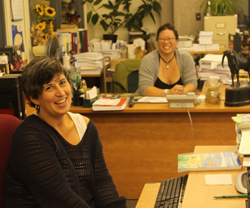PhD Room

We are pleased to report that the 36 seat PHD Room on the 2nd floor of the Redpath Library Building has been completed and the seating allocation has been finalized based on input from the Faculty of Arts and Graduate and Postdoctoral Studies. The main purpose of this room is to provide doctoral students enrolled in humanities and social science programs, especially those preparing their theses, with private, quiet, and secure working space. Other groups considered for assignment are Postdoctoral fellows affiliated with the Faculty of Arts, and other doctoral students selected on merit. The room features 36 desks equipped with lockable drawers and book shelves, a multi-functional printing device, as well as lounge seating for six (6) and coffee/tea/water facilities. The room is fully covered by the wireless network and all tables have electrical outlets.
One hundred students applied for the opportunity to be allocated one of the 36 seats. The duration of the allocation is currently one year but will be reviewed to potentially be on a per term basis. Second year management graduate student Hyeiim Oh loves the new space. “I use the room almost everyday. The locked drawers are very convenient and it’s always super quiet. I appreciate the space very much.”
HSSL Second Floor Shuffle

In early 2010, the Microfilm Viewing Room on the 2nd floor of the McLennan Library Building was re-located to the room next door. This allowed for staff at the Government Information Service Desk to quickly identify and help clients requiring assistance. The space was refurbished with new desks for the six microfilm readers as well as new chairs and a printer. This summer saw the last phase of renovation come to a close with the completion of two large projects: creation of a new teaching space and the amalgamation of office space for for EDRS and Government Information Service staff.
Eamon Duffy says the move has been a positive one for all involved for two main reasons. “The first is that it’s easier, more accessible for students to get help because they don’t have to bounce back and forth, from one place to another. The second reason is that we collaborate more as a staff.”
